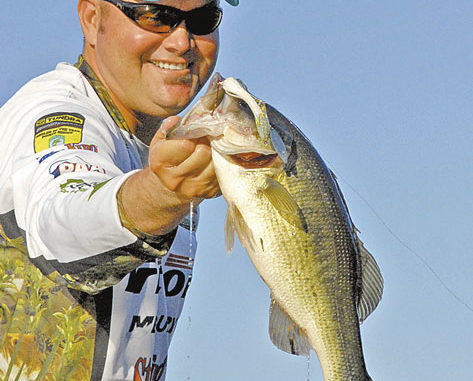
Lake D’Arbonne, located a little northwest of Monroe, is a productive place to catch really big bass this month, although the lake yields nice bass year-round. March is probably the best month to fish this lake because the bass are either in the pre-spawn or the spawning mode, and will be moving into the backwater creeks.
Every year during March, numbers of bass weighing 8 pounds or more are caught from D’Arbonne, and a 15-pound largemouth has even been caught in this body of water. D’Arbonne is a typical lowland reservoir, and many of the bass live offshore until they spawn.
On natural lakes, where bass live close to shore all year, the spawn is really good. However, on a lake like D’Arbonne, where the bass live offshore and then move into the shallow water to spawn, you’re putting a lot of bass in those creek arms and around those cypress trees that aren’t in these regions the rest of the year. These bass generally are structure-oriented and live on creek-channel breaks, humps and ridges out in the main lake for most of the year.
To catch bigger bass this month, search for a grove of cypress trees, and then look for an isolated tree out away from the grove. Many times a really big bass that weighs 6 pounds or more will be near a group of bass but isolated and alone out on that cypress tree. You can fish 10 of those isolated trees and not get a bite, and then pull up to one of those isolated trees and catch a 10-pound largemouth.
Hack Attack jig
The No. 1 technique for catching these big bass in March is to flip cypress trees with jigs. During this time of year, depending on the water’s temperature, I’ll be throwing a 3/8-ounce Strike King Hack Attack jig in the cypress trees. I don’t generally throw a 3/8-ounce jig, but this size jig has the same profile as the bigger jigs with a smaller head that allows the jig to fall more slowly.
Oftentimes when the bass first move up to the shallows, the water temperature may be colder than what most people think about for the spawn. But bass movement patterns depend more on moon phases and the amount of additional light D’Arbonne receives at that time of year, when the daylight hours start lengthening, rather than on water temperature. These bass may not be holding tight to the bottom, but instead will be suspended. If the weather is really cold, and this region has two to three warm days, the bass will suspend around the trees. Oftentimes these bass will be concentrated under an overhanging limb of a cypress tree and just be suspending.
That’s the reason I prefer a lure with a really slow fall, like the 3/8-ounce Hack Attack jig. Then my jig stays in the strike zone of the bass as long as possible. Although the bass may not be in a chasing-bait mode, if you drop a bait near their faces, they’ll attack it.
My favorite color Hack Attack jig is sexy craw, depending on water color. For a trailer in really cold water, I prefer a Strike King Denny Brauer Chunk, because it has very little action and is extremely subtle. On dark days, I like the Okeechobee craw-colored jig, and black/blue is always a productive color. I’ll be fishing exclusively with 50-pound-test braided line. When I’m flipping the jig, I use a 7-foot, 11-inch Quantum Tour Greg Hackney rod and a 7.0:1 gear-ratio Quantum Smoke PT reel.
If the weather is a little warmer, and the bass are more active, I’ll swim the jig around the trees with a Strike King Rage Craw as a trailer. I may even step up from a 3/8- to a 1/2-ounce Hack Attack jig. I can get the same rate of fall with a 1/2-ounce jig and a Rage Craw trailer that I have with a 3/8-ounce jig and a chunk trailer, since the Rage Craw has so much drag in the water.
My favorite technique is slow-swimming the jig. I’ll change rods from the 7-foot, 11-inch rod to the 7-foot, 2-inch Quantum Tour Greg Hackney rod. I’ll cast the jig, rather than flipping it, and swim it around the trees. When I feel the bass take the jig, I’ll take up the slack first and then set the hook. You don’t want to set the hook as soon as the bass inhales the jig, because often the fish will grab the trailer and not have the jig in its mouth. I like to hesitate a second or two to make sure the bass has the jig well in its mouth before I set the hook.
Fishing the swimming jig is much like fishing a rubber frog in the grass. You have to almost wait until you feel the bass on the line before you set the hook. Many times when you’re swimming the jig, you’ll actually see the bass attack. Be sure to set the hook only when you feel the bass on the line.
Spinnerbaits on windy days
On windy days, I’ll fish a spinnerbait. At this time of year, I prefer two willowleaf blades — a No. 4 and a No. 4 1/2. Water color will determine the color skirt I use. In clear water, I prefer smoky shad on a sunny day and golden shiner on a cloudy day. If the water is a little more off-color, I’ll sometimes throw the red crawfish Strike King Premier Plus Spinner Bait, and if the water is really off-color, I prefer chartreuse sexy shad.
The cypress trees will be your best bet for finding bass this month at D’Arbonne. On a good day in March, I’ll get eight to 12 bites there. With these two lures, I’ll probably catch a bass that weighs more than 6 pounds. I’ll be going to Lake D’Arbonne this month, because I’ll be fishing for big bass.


